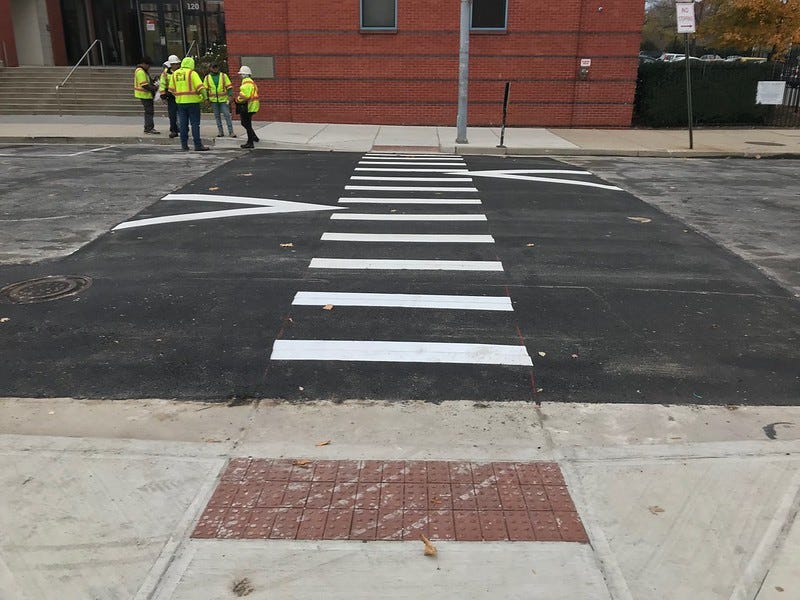Install speed tables as fast as you can
They don't look like much, but they're saving lives around the world.
If speed tables are so good, why are drivers so mad? Because speed tables slow down drivers, drivers who have been conditioned to speed all the time.
If drivers are mad, shouldn't speed tables be removed? No. Slowing drivers to a speed that's appropriate for the context is a key way to reduce crashes and save lives.
A crash at 30 MPH involves twice as much kinetic energy and destructive potential as a crash at 20 MPH. Physics explains why a person hit at 30 MPH has a 1-in-5 chance of being killed. It should be painfully obvious that traffic calming is a life-and-death issue in towns, cities, or any other place where people often move around without motor vehicles.
The idea that we should never experience delay is so ingrained in our culture that we twist “no extra delay” into “as fast as possible.” Physical traffic calming devices—stuff in the street—is the quickest way to slow people down. Some drivers will stay mad. Fine.
In the olden days, speed bumps were one of the common treatments to get drivers to chill out in parking lots and around schools. But at any speed, driving over those made your teeth hurt. Speed tables have the same calming goal, but they have a wide, flat top that smoothly integrates with the road's surface that makes them less abrupt. It’s comfortable to go slowly over them, but uncomfortable to speed.
This study published in Civil Engineering and Architecture focused on how certain measures can make roads safer by slowing down cars, especially in cities. It looks at three ways to calm traffic: speed tables, chicanes (curvy roads), and making roads narrower.
All three traffic calming methods helped reduce car crashes by more than 30%. But get this: speed tables were so effective they sometimes cut average car speeds in half. You guys, what are we waiting for?! Here’s why they’re becoming such a popular tool for local public works departments:
Increasing Visibility: The raised design of speed tables makes them more visible to drivers than traditional flat road markings, serving as a physical reminder to reduce speed.
Improving Pedestrian Safety: Speed tables can double as pedestrian crossings, providing a raised, level surface that improves pedestrian visibility and encourages drivers to yield. This feature is particularly beneficial on streets around schools, parks, and residential communities.
Psychological Impact: The presence of speed tables can have a psychological effect on drivers, signaling that they are entering a zone where caution and reduced speed are expected. Psychological cues are one of the persuasion devices that will help shift America's safety culture.
Reducing Crash Severity: When crashes do occur, the reduced vehicle speeds associated with traffic calming measures like speed tables mean that crashes are less severe. Lower speeds reduce the kinetic energy involved in a crash, which directly correlates to the severity of injuries.
In the traffic calming evaluation, not only did narrowing lanes, chicanes, and speed tables decrease the number of crashes, they also made the crashes that did happen less severe. The number of people getting hurt went down by 32% to 50%, depending on the method used. Pedestrian safety also improved significantly, with injuries dropping by 33% to 50%.
Speed tables led to a 40% decrease in injuries and completely eliminated deaths.
It seems like such a simple intervention, but it’s got incredible potential. Richmond, VA, where I’m based, is installing speed tables every time neighborhoods are repaved. It’s becoming muscle memory for the paving crew. They smooth out the streets, narrow lanes, add bike lanes, and install speed tables. Alright, ask me anything.






Yes. Urban areas should be all about pedestrians. Everything we build in an urban area should benefit the people who walk -- walkable neighborhoods, connections to other parts of the city via walking, bike paths, public transportation, even those shitty little scooters. But cars, yes, we need to build infrastructure for cars -- infrastructure that slows them and limits the damage they cause.
I live just south of a dangerous S-curve, with a posted advisory speed limit of 25mph, on a "minor arterial" where the legal speed limit is 40. There was yet another deadly crash where a drunk driver ran off the road and killed workers in someone's front yard in September 2022. The City made plans to install transverse thermoplastic rumble strips to warn drivers about the upcoming S-curve, thinking that that would solve it. I called Traffic Engineering and asked about instead installing raised crosswalks on either end of the S-curve to force compliance with the 25mph advisory speed limit (and allow neighbors to actually cross the street), and I was told that the City couldn't do that because slowing down cars to the actual advised speed by speed table would cause so much congestion that "you wouldn't be able to get out of your driveway." The City's commitment to keeping this road functioning at an acceptable LOS for an arterial and requiring commuting motorists to navigate this dangerous S-curve at well-above the advised speed for the 2 horizontal curves, while also providing residential access and seeming to care about loss-of-life, is a kind of trying to "have your cake and eat it too." What it really says to me is that the loss of life is bad, but impeding commuting motorists is worse.